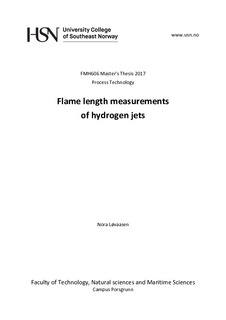| dc.description.abstract | The use of hydrogen is increasing rapidly and the research on hydrogen safety must follow. The implementation of hydrogen filling stations and cars are steadily on the rise. In the case of a leakage the hydrogen will most likely ignite, it is therefore essential to map out and reduce the risk of accidents. In addition to mapping out the risks, it is necessary to have safety-related data for potential hazardous scenarios in the case of an accident.
Experiments were conducted with different nozzle configurations as to investigate the impact this would have on the flame length of hydrogen jets. This report has taken a new direction by studying a more complex geometry of the nozzle. In addition to measure the flame length with a single upstream nozzle, it was investigated how a larger downstream nozzle would impact the flame length.
All the jets were placed vertical with inner nozzle diameters ranging from 0.5 mm to 4 mm. The spouting pressure from the reservoir was in the range of 20 to 100 bars. The results are compared with the HySAFER model, which is the most current engineering method for calculating flame length. All the results, with one exception, obtained from the executed experiments are within the margin of error set for the HySAFER model. | nb_NO |
